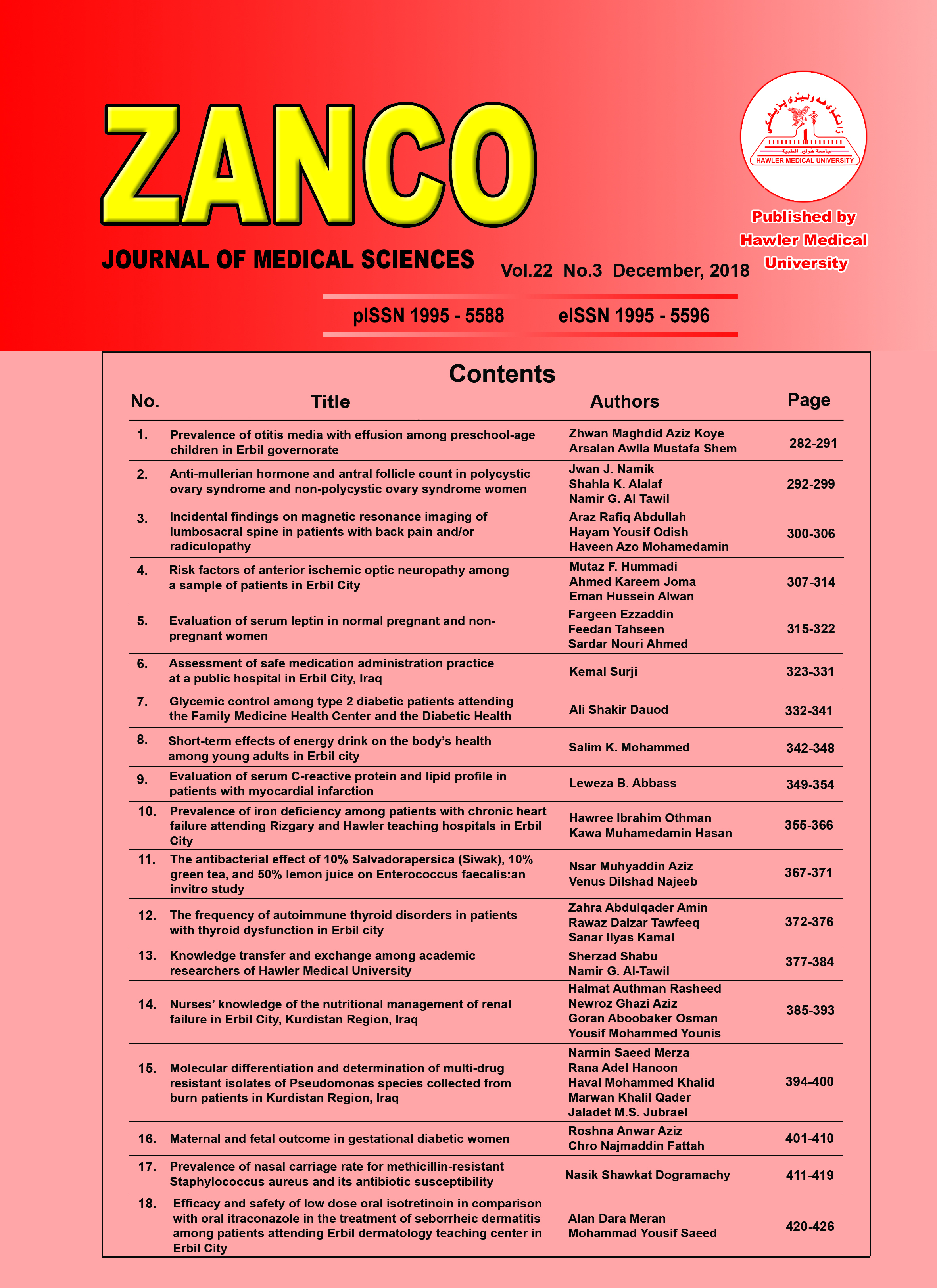
This work is licensed under a Creative Commons Attribution-NonCommercial-ShareAlike 4.0 International License.
- Articles
- Submited: January 7, 2019
-
Published: December 31, 2018
Abstract
Background and objective: Thyroid disorders are one of the most frequent pathologies found in the general population, but identifying thyroid disease can be clinically challenging because subclinical thyroid dysfunction and autoimmune thyroiditis are often asymptomatic and usually diagnosed biochemically. This study aimed to distinguish the autoimmune thyroid diseases from other forms of thyroid dysfunctions in patients admitted to PAR hospital in Erbil city.
Methods: blood was withdrawn from healthy subjects, and unhealthy patients suffer from thyroid dysfunction, their age and gender were recorded, and their blood serum were subjected to test the thyroid function antibodies including triiodothyronine T3, thyroxin T4, and thyroid stimulating hormone TSH. Also, autoimmune antibodies were tested including anti-thyroglobulin antibody (anti-TGA) and thyroperoxidase antibody (TPO antibodies).
Results: no significant differences were shown in T3 levels while contrary highly significant differences were shown in T4, TSH anti-TGA and anti-TPO levels between healthy subjects and unhealthy patients groups. The percentages of autoimmune thyroid diseases were (45.2%) as compared to the other forms of thyroid dysfunctions (54.8%). Most of the patients were females in the age group 30-39 years.
Conclusion: In Erbil city population/PAR hospital the prevalence of autoimmune thyroid diseases were more frequent among other thyroid diseases collectively. It is mostly found in females rather than males within the age group 30-39 years.
Metrics
References
- Antonelli A, Ferrari SM, Corrado A, Di Domenicantonio A, Fallahi P. Autoimmune thyroid disorders. Autoimmun Rev 2015; 14(2):174–80.
- Tozzoli R, Villalta D, Bizzaro N, Tonutti E, Manoni F. Laboratory diagnosis of autoimmune thyroid disease. Recenti Prog Med 2001; 92(10):609–17.
- Szyper-Kravitz M, Marai I, Shoenfeld Y. Coexistence of thyroid autoimmunity with other autoimmune diseases: friend or foe? Additional aspects on the mosaic of autoimmunity. Autoimmunity 2009; 38(3):247.
- Schott M, Scherbaum WA. Autoimmune thyroid disease. Dtsch Arztebl 2006; 103(45):3023–32.
- Bello G, Ceaichisciuc I, Silva S, Antonelli M. The role of thyroid dysfunction in the critically ill: a review of the literature. Minerva Anestesiol 2010; 76(11):919–28.
- Iddah M, Macharia B. Autoimmune thyroid disorders. ISRN Endocrinol 2013; 2013.
- Ladenson PW, Singer PA, Ain KB, Bagchi N, Bigos ST, Levy EG, et al. American Thyroid Association guidelines for detection of thyroid dysfunction. Arch Intern Med 2000; 160(11):1573–5.
- Hollowell JG, Staehling NW, Flanders WD, Hannon WH, Gunter EW, Spencer CA, et al. Serum TSH, T4, and thyroid antibodies in the United States population (1988 to 1994): National Health and Nutrition Examination Survey (NHANES III). J Clin Endocrinol Metab 2002; 87(2):489–99.
- Perros P, McCrimmon R, Shaw G, Frier B. Frequency of thyroid dysfunction in diabetic patients: value of annual screening. Diabet Med 1995; 12(7):622–7.
- Tomer Y, Davies TF. Infection, Thyroid Disease, and Autoimmunity. Endocr Rev 1993; 14(1):107–20.
- Vaidya B, Kendall-Taylor P, Pearce SH. The genetics of autoimmune thyroid disease. J Clin Endocrinol Metab 2002; 87(12):5385–97.
- Mantovani RM, Mantovani LM, Dias VM. Thyroid autoimmunity in children and adolescents with type 1 diabetes mellitus: prevalence and risk factors. J Pediatr Endocrinol Metab 2007; 20(6):669–76.
- Kordonouri O, Deiss D, Danne T, Dorow A, Bassir C, Grüters-Kieslich A. Predictivity of thyroid autoantibodies for the development of thyroid disorders in children and adolescents with Type 1 diabetes. Diabet Med 2002; 19(6):518–21.





